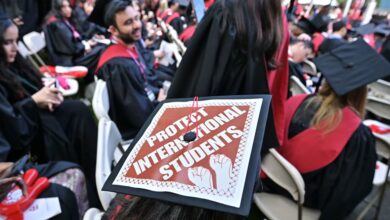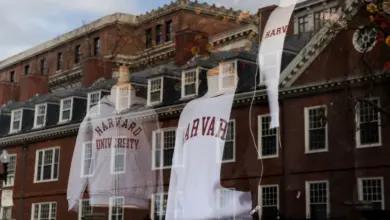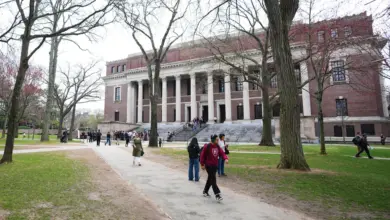Adidos. Magdonal. Egyptfacebook.com. There’s no shortage of knock-off brands and cheap imitations infiltrating today’s marketplace. Established names and reliable products have been bastardized in every possible sense by society’s laziest leeches in a ravenous bid to profit from the success and well-earned reputation of others. Al-Masry Al-Youm paid a visit to two schools in order to measure the extent of this phenomenon’s latest, and perhaps most worrying, manifestation.
STANFORD AMERICAN SCHOOL
Upon arrival, the only indication that the single, three-storey structure awkwardly situated in the corner of an otherwise vacant plot of land is, in fact, the Stanford American School, came from the repetitive chant floating out from one of the building’s windows: A high-pitched shriek of heavily-accented English, met with a louder, albeit far less enthusiastic response, as a roomful of audibly bored students dutifully repeat the phrase “Een frant of.”
Stanford American School’s campus is fairly unremarkable. There are no logos or identifying signs of any sort, save for the one hanging from a lamppost at the end of the street. Besides its single schoolhouse (which also contains the ‘amdinistrative’ [sic] offices) and the winding path leading up to it, a freshly-mowed lawn stretches across the 2.5 acre campus, interrupted by two rectangular patches of asphalt that, if the shoddy goalposts are to be taken seriously, serve as the school’s respective soccer and basketball courts.
This minimalist attitude extends to the main reception, which consists of two rows of standard ‘waiting area’ chairs, a children’s tea-table set in one corner, and a water cooler minus the water container in another corner. Despite having an appointment, Al-Masry Al-Youm waited for over an hour to meet with the owner—more than enough time to wander the school’s three hallways, all of which were covered with typically chaotic pre-school illustrations and black-and-white Halloween-themed printouts.
Stanford has between eight to twelve functioning classrooms—it’s hard to differentiate between those that were in use and those that weren’t. Of the rooms that were occupied at the time of Al-Masry Al-Youm’s visit, not much seemed to be going on. In one classroom, a group of unsupervised children kept themselves busy by either rolling around on the carpet, or napping in a number of oversized cribs lined up against the back wall. The adjacent classroom hosted a similar scene, with the addition of an alarmingly young-looking foreign teacher sitting on her desk, fiddling with her iPod.
Back on the ground floor, Al-Masry Al-Youm naively followed a sign pointing towards the school’s ‘cafeteria’, which, as it turned out, consisted of several bags of potato chips, cookies, and other assorted junk food, laid out on a card table in one of the school’s two stairwells. Across from the table was a refrigerator from which soda drinks are sold at more than double their market price.
With the recess bell sounding and still no sign of the school’s owner, Al-Masry Al-Youm turned its attention to the 22 kids running around the soccer court, none of whom seemed older then 10 or 11, and all sporting the same uniform with ‘Stan’ and ‘Ford’ stitched as two separate words on their chest pockets.
A quick stroll around the campus confirmed the absence of any of the facilities required from a private educational institution, such as an auditorium, gymnasium, or swimming pool. It’s hard to imagine a school not having a library, so this reporter will simply state that if Stanford does indeed have one, he couldn’t find it.
Arriving 82 minutes late and dressed in jeans and a polo shirt, 24-year-old Amr Rady Galal casually shrugged off his tardiness, explaining to Al-Masry Al-Youm, “My Mercedes was making a strange sound.”
Instead of an office, Galal led the way out to the school’s lawn, where a plastic table and three chairs—including one for Galal’s friend who tagged along—had been set up under an umbrella. After lighting a cigarette and offering one to everyone present, Galal was finally ready to talk about his school. “We were never attempting to mislead people by naming our school Stanford,” Galal explains. “Besides, who said we named our school after Stanford University? There are plenty of Stanfords out there. There’s a town called Stanford, and a pencil company called Stanford. It’s just a word, like any other.”
When asked if he named his school after a pencil company, Galal merely smiles and says, “Sure, why not?”
Besides being named after a fictitious pencil company—he probably meant Sanford—, Galal’s Stanford American School is also misleading in that there’s nothing particularly American about it. “We are not an American school and we do not offer the American diploma,” Galal admits bitterly. “We did submit an official request to the Ministry of Education before we even opened, but it was denied. So, the intention was there.”
According to Galal, a recent graduate of the American University in Cairo, this denial was not due to any weakness in his school, but rather, typical bureaucracy. “The Minister of Education passed a law earlier this year prohibiting any new international schools.” The reason, Galal suggests, is because “they just like to make things harder.”
However, Galal has not let the government’s obstinacy stand in his way; Stanford American School has been up and running for two years now, with definite plans for expansion. “As of now, we only have students from kindergarten to grade six, but soon we’ll have students graduating from Stanford.”
When asked about the extra-curricular activities his school offers, Galal hesitates before answering, “art, P.E., and music. And also Koran lessons.” He also claims his school has negotiated several exchange programs and scholarships with universities abroad, yet refused to name any of them. It is probably safe to assume that Stanford—the one not named after a pencil manufacturer—is not one of them.
Five minutes into the interview Galal, apparently tired of answering questions, suggested that Al-Masry Al-Youm check the school’s website instead. “Everything you’ll want to know is on there,” he huffed.
Keep in mind, however, that according to Stanford’s website, ‘some of whats written in the website does not express stanford school's opinion [multiple sic].’
HARVARD ENGLISH COLLEGE
Located halfway down a dirt road across the street from a cemetery, Harvard English College is a strange sight to behold. With its resemblance to an overgrown gingerbread house, the building is a confusion of styles, strongly reflected in its interior. The school goes by two names: "al-Rabwa" if your child is a student of the national curriculum, and "Harvard" if you’ve paid for something only slightly fancier. For example, the Harvard school’s motto, as printed on the poster hanging by the main entrance, is: “Develop a generation of effective global-minded thinkers.” Al-Rabwa, on the other hand, doesn’t seem to have one.
The reception area disorients with its combination of chairs, stools, overwhelming stench of cigarette smoke, and red, green, and white walls (one wall recklessly combines all three) giving the whole area an unsuccessful-Italian-restaurant vibe. Ceran-wrapped oil paintings hang on all walls. At the far end of the reception, next to the fake marble fireplace, is the P.E. teacher’s desk. A bulletin board in the middle of the room advertises the Harvard Soccer Academy, and the Music Club, where students can learn to play, among other things, the ‘exceliphons.’
The tour given by the school’s "legal representative" Tarek Osman—who was only 45 minutes late to the appointment and exceedingly friendly—revealed several unusual features. Past the welcoming committee of life-sized cardboard cutout soccer players, the campus seems far bigger than its exterior suggests. There were the expected library, cafeteria, and soccer field (although the students were still seen playing on a concrete courtyard). The real surprises, however, lay in the basement.
Besides several large images of President Hosni Mubarak, Harvard Egypt College’s basement houses a cinema and an "auditorium"—both with extremely limited seating and separated by a thin black curtain. Despite the fact that, at the time of visit, the cinema was screening a pirated action film for a single, bored technician, Osman assures Al-Masry Al-Youm that its use is reserved for strictly educational purposes. Beyond the screen/stage stands a towering fleet of industrial machines, which Osman identified as the "autoshop," where students can learn how to make and assemble car parts. Further down is another factory’s worth of mechanical contraptions—industrial-size ovens, blenders, grinders and mincers. “This is where students will be taught to cook,” said Osman while gesturing towards an adjacent cafeteria. “And they will serve the food there. Only the staff is allowed to eat in this cafeteria.” He paused before smiling broadly. “The students will cook for us.”
Neither the autoshop nor the student-run cafeteria are operable yet, but they soon will be, Osman promised.
“These ideas are all from Harvard,” he explained, speaking of his school’s far more prominent namesake in Cambridge, Massachusetts. The tour continued as Osman led the way past a room full of gutted computers, VCRs and microwave ovens. “We want to apply their teaching methods to our system. This is the American style of teaching. The emphasis is on practical learning more than theoretical, designed to better suit the students’ needs and talents.”
Back in his office, and under the president’s intense glare, Osman boasted of the Harvard ballet school, its religion classes catering to both Muslim and Christian beliefs, and its special needs program, designed for children with Down’s syndrome or autism. All of which sounded fine, until irreversibly compromised by his next statement: “There’s a school in Boston called Harvard, which we are setting up exchange programs with. We communicate with them on a regular basis. The program will help students by granting them full scholarships and financial aid.”
Each time he was asked, Osman confidently confirmed his school’s association with Harvard University—a claim that comes as a surprise, to say the least, to the latter’s administration. When contacted for any information or comments on their supposed affiliation, Kevin Galvin, Director of News and Media Relations at Harvard University, replied in an email:
“Harvard University takes the unauthorized use of its trademarks very seriously, especially in the area of higher education, and it pursues the infringement of the HARVARD name in the field of education around the world. Harvard University does not license or permit unaffiliated parties to use the HARVARD name in the field of education and any schools in Egypt using HARVARD in their name have not been authorized to do so by Harvard University.”
Furthermore, neither Harvard English College nor Stanford American School have been accredited by any legitimate institution. According to Marwa Yehya, a program assistant at AmidEast Egypt, the two schools are not, and have never been, recognized candidates—meaning they never even bothered to apply for proper accreditation, despite whatever claims are made by their legal representatives and owners.
While it is somewhat depressing to think of supposed educational institutions so blatantly built on deception and the manipulation of gullible or superficial parents, the existence of either Harvard Egypt College or Stanford American School is not particularly surprising, given how education in Egypt has become more of a trend than a necessity—one characterized by the same crippling affinity for recognizable names and high-status labels. As a result, both "Harvard" and "Stanford" have seen a rise in their student population over the past year.
During the seemingly eternal wait at Stanford American School, a curious parent arrived at the reception office, asking to speak to someone from the administration. After the receptionist left to find someone capable of giving the appropriate information, Al-Masry Al-Youm asked the mother, who wished to remain anonymous, why she was considering transferring her two children to Stanford. “I heard there was an international school here so I came to check it out,” she explained. “I don’t know anything about this school, or anyone who has children in it. But it sounds promising.”




